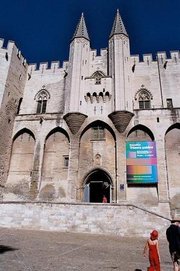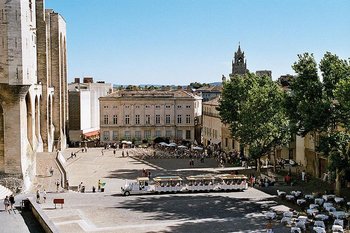Avignon
|
|
- This article is about the city in France, for the Municipality in Quebec, see Avignon Regional County Municipality, Quebec.
Avignon_coat_of_arms.jpg
Avignon (pronounced in IPA, Provençal: Avignoun) is a commune in southern France with some 88,300 inhabitants in the city itself and 155,500 in the Greater Avignon area. It is twinned with Colchester, UK.
| Contents |
Location
Rhone_Avignon_from_TGV_DSC00181.jpg
Avignon is situated on the left bank of the Rhône, in the Vaucluse département, about 400 miles south-south-east of Paris, and 50 miles north-north-west of Marseille. Its coordinates are Template:Coor dm.
Administration
Avignon is the préfecture (capital) of the Vaucluse département. It forms the core of the Grand Avignon metropolitan area (communauté d'agglomération), which comprises twelve communes on both sides of the river:
- Les Angles, Rochefort-du-Gard, Saze and Villeneuve-lès-Avignon in the Gard département;
- Avignon, Caumont-sur-Durance, Jonquerettes, Morières-lès-Avignon, Le Pontet, Saint-Saturnin-lès-Avignon, Vedène and Velleron in the Vaucluse département.
History
Early history
The site of Avignon was settled very early on; the rocky outcrop (le Rocher les Doms) at the north end of the town, overlooking the Rhône, may have been the site of a Celtic oppidum or hill fort. During the Roman Empire the city was a major center of Gallia Narbonensis, but very little from this period remains (a few fragments of the forum near Rue Molière). It was badly damaged by the barbarian invasions of the 5th century and was destroyed in 737 by the Franks under Charles Martel, after it had sided with the Arabs against him. Avignon passed successively to the kingdom of the Burgundians and the Kingdom of Arles. At the end of the 12th century, its commune declared itself an independent republic, but independence was crushed in 1226 when Avignon was taken and dismantled by forces of Louis VIII and its fortification demolished as punishment for its support of the Cathars. Avignon was given to the counts of Provence and then the counts of Toulouse.
The town had significant religious status from ancient times. It was the seat of a bishop as early as the year 70 AD, and became an archbishopric in 1476. Several synods of minor importance were held there, and its university, founded by Pope Boniface VIII in 1303 and famed as a seat of legal studies, flourished until the French Revolution.
In 1309 the city was chosen by Pope Clement V as his residence, and from that time till 1377 was the seat of the Papacy, in the "Babylonian Captivity." In 1348 the city was sold by its owner, Joanna, countess of Provence, to Pope Clement VI and, though it was later the seat of more than one antipope Avignon belonged to the Papacy until the French Revolution.
Avignon under the Popes
Avignon became the residence of the Pope in 1309, at which time the town and the surrounding Comtat Venaissin was under the rule of the kings of Sicily (the house of Anjou). In 1348 Pope Clement VI bought it from Queen Joanna I of Sicily for 80,000 gold gulden, and it remained a papal possession until 1791, when, during the disorder of the French Revolution, it was incorporated with France.
Avignon-palais.jpg
Seven popes resided there:
- Pope Clement V
- Pope John XXII
- Pope Benedict XII
- Pope Clement VI
- Pope Innocent VI
- Pope Urban V
- Pope Gregory XI
This period from 1309–1377 was also called the Babylonian Captivity, in reference to the Israelites' enslavement in biblical times. The analogy fitted Avignon in another sense—the venality of the papal court caused the city to become infamously corrupt, much as Babylon had been accused of being. The poet Petrarch condemned the city's corruption, contributing to the papacy's return to Rome out of sheer embarrassment as much as anything else.
The return to Rome prompted the Great Schism, during which the antipopes Clement VII and Benedict XIII continued to reside at Avignon. The former lived there during his entire pontificate (1378–1394), the latter until 1408, when he fled to Aragon.
The walls built by the popes in the years immediately succeeding the acquisition of Avignon as papal territory are well preserved. They were not, however, particularly strong fortifications; the Popes relied instead on the immensely strong fortifications of their palace, the "Palais des Papes". This lofty Gothic building, with walls 17–18 feet thick, was built 1335–1364 on a natural spur of rock, rendering it all but impregnable to attack. After being expropriated following the French Revolution, it was used as a barracks for many years but is now a museum.
After the departure of the popes, Avignon continued to be ruled by legates as papal territory. Its existence was, however, somewhat precarious, as the French crown maintained a large standing garrison at Villeneuve-les-Avignon just across the river. In 1663 and 1688 the French King Louis XIV occupied the surrounding Comtat Venaissin. The papacy finally lost the town and the Comtat in 1791, when it was incorporated into France after the French Revolution.
Sights
- Notre Dame des Doms
- Palais des Papes
- Pont d'Avignon (Pont St-Bénezet)
Miscellaneous
A famous theater festival is held annually in Avignon. Founded in 1947, the Avignon Festival comprises both traditional theatrical events and other art forms such as dance, music and cinema, making good use of the town's historical monuments.
Avignon is commemorated by the French children's song, "Sur le pont d'Avignon" ("On the bridge of Avignon"), which describes folk dancing. The bridge of the song is the Saint Bénezet bridge, over the Rhone River, of which only four arches (out of the initial 22) starting from Avignon side remain. In fact people would have danced beneath the bridge (sous le pont) where it crossed an island (l'Ile de Barthelasse) on its way to Villeneuve-lès-Avignon. The bridge was initially built between 1171 and 1185, with an original length of some 900 m (2950 ft), but it suffered frequent collapses during floods and had to be reconstructed several times. Several arches were already missing (and spanned by wooden sections) before the remainder was damaged beyond repair in 1660.
Famous residents include: (born in Avignon)
- Jean Alesi, race car driver
- Pierre Boulle, author of The Bridge on the River Kwai and Planet of the Apes
- Alexandre de Rhodes (1591-1660), Jesuit missionary
- Mireille Mathieu, singer
- Bernard Kouchner, politician
- Henri Bosco, writer
- Joseph Vernet, painter
External links
- Tourist office website (http://www.ot-avignon.fr)
- City council website (http://www.avignon.fr)
- Avignon theater festival website (http://www.festival-avignon.com)
- University of Avignon (http://www.univ-avignon.fr/)bg:Авиньон
ca:Avinyó (França) cs:Avignon da:Avignon de:Avignon it:Avignone es:Aviñón fr:Avignon he:אביניון nl:Avignon ja:アヴィニョン no:Avignon pl:Awinion pt:Avinhão ro:Avignon ru:Авиньон fi:Avignon sv:Avignon


